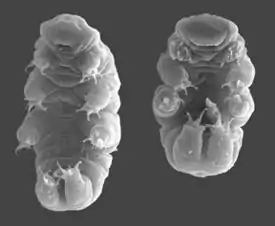Eutardigrada
Eutardigrada (лат.) — класс тихоходок. Главным образом, пресноводные, но некоторые виды вторично приспособились к морским условиям обитания (Halobiotus). Коготки со слитыми первичной и вторичной ветвями, очень редко коготки редуцированы или отсутствуют. На голове нет придатков (усиков) и покровы эластичные. Часть видов способны временно жить в очень сухих условиях. Описано более чем 700 видов[1][2][3].
| Eutardigrada | ||||||||||
|---|---|---|---|---|---|---|---|---|---|---|
 Тихоходка Hypsibius dujardini | ||||||||||
| Научная классификация | ||||||||||
|
Домен: Царство: Подцарство: Без ранга: Без ранга: Без ранга: Без ранга: Надтип: Тип: Класс: Eutardigrada |
||||||||||
| Международное научное название | ||||||||||
| Eutardigrada Marcus, 1927 | ||||||||||
| ||||||||||
Отряд Apochela включает единственное семейство Milnesiidae с двумя родами: Milnesium и Limmenius. Вид Milnesium tardigradum встречается повсеместно и это один из крупнейших видов тихоходок, который может достигать в длину 1,4 мм; сходные ископаемые виды найдены в меловом янтаре[4]. Рот этих хищников имеет широкое отверстие, поэтому они могут поедать коловраток и крупных простейших одноклеточных. Другие Eutardigrada принадлежат к отряду Parachaela. В 2019 году было предложено выделить Apochela в отдельный четвёртый класс тихоходок Apotardigrada[1], но уже в 2021 году выражены сомнения в статусе Apotardigrada[5].
Классификация
Источники: Bertolani et al., 2014; Cesari et al., 2016; Guidetti et al, 2016; Vecchi et al., 2016[1][6][7][8][9][10][11][12].
- Отряд Apochela Schuster et al., 1980 (или отдельный класс Apotardigrada)[1]
- Milnesiidae Ramazzotti, 1962
- Отряд Parachaela Schuster et al., 1980
- Надсемейство Eohypsibioidea Bertolani & Kristensen, 1987
- Eohypsibiidae[13]
- Надсемейство Hypsibioidea Pilato, 1969
- Calohypsibiidae
- Hypsibiidae
- Microhypsibiidae
- Надсемейство Macrobiotoidea Thulin, 1928
- Beornidae
- Macrobiotidae
- Necopinatidae
- Richtersiidae
- Надсемейство Eohypsibioidea Bertolani & Kristensen, 1987
- Отряд Isohypsibioidea Sands et al., 2008[1]
- Надсемейство Isohypsibioidea Sands et al., 2008
- Isohypsibiidae Sands et al., 2008
- Надсемейство Isohypsibioidea Sands et al., 2008
Примечания
- Guil N., Jørgensen A. & Kristensen, R. An upgraded comprehensive multilocus phylogeny of the Tardigrada tree of life (англ.) // Zoologica Scripta. — Norwegian Academy of Science and Letters, 2019. — Vol. 48, iss. 1. — P. 120—137. — ISSN 1463-6409. — doi:10.1111/zsc.12321.
- Guidetti R. & Bertolani, R. Tardigrade taxonomy: an updated check list of the taxa and a list of characters for their identification (англ.) // Zootaxa : Журнал. — Auckland, New Zealand: Magnolia Press, 2005. — Vol. 845. — P. 1—46. — ISSN 1175-5326.
- Zhang, Z.-Q. Animal biodiversity: An introduction to higher-level classification and taxonomic richness (англ.) // Zootaxa : journal. — 2011. — Vol. 3148. — P. 7—12.
- Budd, G. Tardigrades as 'Stem-Group Arthropods': The Evidence from the Cambrian Fauna (англ.) // Zoologischer Anzeiger : journal. — 2001. — Vol. 240, no. 3—4. — P. 265—279. — ISSN 0044-5231. — doi:10.1078/0044-5231-00034.
- Fleming J. F., Kazuharu Arakawa. (2021). Systematics of tardigrada: A reanalysis of tardigrade taxonomy with specific reference to Guil et al. (2019). Zool. Scripta, Volume 50, Issue 3, May 2021, Pages 376-382. First published: 29 January 2021 https://doi.org/10.1111/zsc.12476
- Bertolani, R., Guidetti, R., Marchioro, T., Altiero, T., Rebecchi, L., & Cesari, M. (2014). Phylogeny of Eutardigrada: New molecular data and their morphological support lead to the identification of new evolutionary lineages. Molecular Phylogenetics and Evolution, 76, 110—126. https://doi.org/10.1016/j.ympev.2014.03.006.
- Cesari, M., Vecchi, M., Palmer, A., Bertolani, R., Pilato, G., Rebecchi, L., & Guidetti, R. (2016). What if the claws are reduced? Morphological and molecular phylogenetic relationships of the genus Haplomacrobiotus May, 1948 (Eutardigrada, Parachela). Zoological Journal of the Linnean Society, 178, 819—827. https://doi.org/10.1111/zoj.12424.
- Guidetti, R., Rebecchi, L., Bertolani, R., Jönsson, K. I., Kristensen, R. M., & Cesari, M. (2016). Morphological and molecular analyses on Richtersius (Eutardigrada) diversity reveal its new systematic position and lead to the establishment of a new genus and a new family within Macrobiotoidea. Zoological Journal of the Linnean Society, 178, 834—845. https://doi.org/10.1111/zoj.12428.
- Vecchi, M., Cesari, M., Bertolani, R., Jönsson, K. I., Rebecchi, L., & Guidetti, R. (2016). Integrative systematic studies on tardigrades from Antarctica identify new genera and new species within Macrobiotoidea and Echiniscoidea. Invertebrate Systematics, 30, 303—322. https://doi.org/10.1071/IS15033
- Kristensen, R. M. (1987). Generic revision of the Echiniscidae (Hetrotardigrada), with a discussion of the origin of the family. Selected Symposia and Monograph UZI, 1, 261—335.
- Pilato, G., & Binda, M. G. (2010). Definition of families, subfamilies, genera and subgenera of the Eutardigrada, and keys to their identification. Zootaxa, 2404, 1—54. https://doi.org/10.5281/zenodo.194138.
- Schuster, R. O., Nelson, D. R., Grigarick, A. A., & Christenberry, D. (1980). Systematic criteria of the Eutardigrada. Transactions of the American Microscopical Society, 99, 284—303. https://doi.org/10.2307/3226004
- Pilato G. (1989). Phylogenesis and systematic arrangement of the family Calohypsibiidae Pilato, 1969 (Eutardigrada). Journal of Zoological Systematics and Evolutionary Research, 27, 8—13. https://doi.org/10.1111/j.1439-0469.1989.tb00433.x.
Литература
- Nelson Diane R. 2002. Current Status of the Tardigrada: Evolution and Ecology. Integrative and Comparative Biology, Volume 42, Issue 3, July 2002, Pages 652—659, https://doi.org/10.1093/icb/42.3.652
- Nelson D. R., Roberto Guidetti, Lorena Rebecchi. 2010. Tardigrada. In book: Ecology and Classification of North American Freshwater Invertebrates, December 2010, pp.455—484. https://doi.org/10.1016/B978-0-12-374855-3.00014-5
- Pilato G. 2013: The taxonomic value of the structures for the insertion of the stylet muscles in the Eutardigrada, and description of a new genus. Zootaxa 3721(4): 365—378. https://doi.org/10.11646/zootaxa.3721.4.4
- Pilato G.; Binda, M.G. 2010: Definition of families, subfamilies, genera and subgenera of the Eutardigrada, and keys to their identification. Zootaxa, 2404: 1—54. http://dx.doi.org/10.11646/zootaxa.2404.1.1
- Pilato G.; Lisi, O. 2014: An exceptional event during the moulting process of an eutardigrade: two bucco-pharyngeal apparatuses present. Zootaxa 3802(2): 297—299. https://doi.org/10.11646/zootaxa.3802.2.11
- Schuster R.O., Nelson, D.R., Grigarick, A.A., and Christenberry, D., 1980. Systematic Criteria of the Eutardigrada. Transactions of the American Microscopical Society, vol. 99, no. 3: 284—303. http://www.jstor.org/pss/3226004
Ссылки
- Tardigrada Newsletter (англ.)
- Tardigrades — Рисунки и видео
- The Edinburgh Tardigrade project (англ.)
- Тихоходки (англ.)